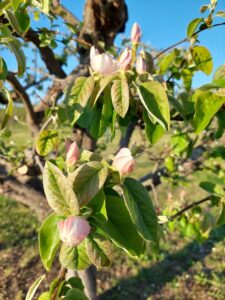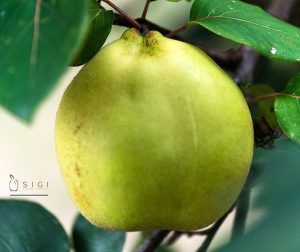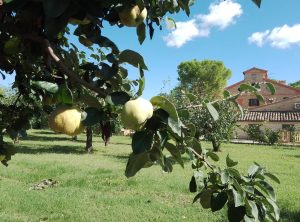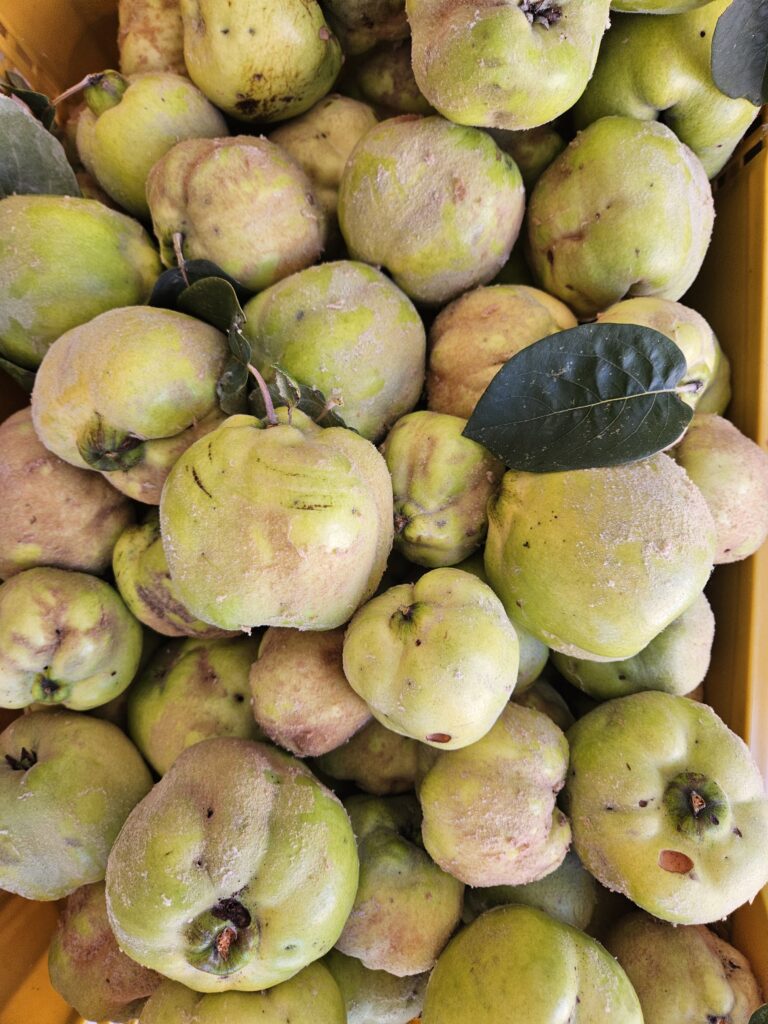THE QUINCE TREE
In local dialect: “Lu Co’gna”
Cydonia oblonga Mill.
Rosaceae

The quince (Cydonia oblonga) is an ancient fruit tree that has been known and cultivated for over 2,000 years.
📍Origin: It is believed to be native to Crete, and its scientific name may derive from the ancient toponym ‘Cydonia’, a city on the island
🌳Small-sized tree: It can grow up to 3-5 meters tall and it has a wide, irregular crown.
🍃Deciduous leaves: The tree has oval leaves that are dark green on the upper side and tomentose (covered with fine, white fuzz) on the underside.
🌸Hermaphrodite blossom: it is solitary and can be white or pink in colour; it blooms in late spring.
🍏Fruit (pome): The fruit is large, yellow-golden in colour, and fragrant. Its pulp is hard and astringent, making it unsuitable for fresh consumption.
🌱Shallow roots: its roots are not deep but are well-developed, making the tree drought resistant.
🍂 Growth and longevity: This is a long-lived plant that can live over 50 years under favourable conditions.

📜 HISTORICAL MENTIONS
🌿 Symbol of fertility: the ancient Greeks called this fruit “golden apple” and considered it a wish for prosperity and fertility
👰Wedding ceremony: It was offered to brides on their wedding night.
🏺 The myth of Hesperides: some believe that the golden pome kept in the garden of Hesperides, protagonist of the labours of Hercules, was a quince
✒️ Costanzo Felici from Piobbico (1572) praises the quince tree in his essay on botany , by saying that the quince is highly valued in cooking for its pleasant aroma, flavour, and properties
📖 “According to Felici, it is used in various ways, both raw and cooked, and can be prepared with different ingredients such as water, wine, must, honey, and sugar. The quince is used to make sweets like quince cheese, jellies, and even savoury dishes. It is also added to dishes like roasts and soups and is considered a versatile ingredient that delights the palate in many recipes.
📖Virgil, in his Georgics (Book II, lines 87-88, 29 BC), celebrates the quince:
“Nec setius teneris iactatur Cydonia pomis
Auratæque mala.”
📜 Traduzione:
“Nonetheless, the quinces with tender fruits are cultivated,
And the golden apples.”
🔹 Virgil describes the quince as a precious fruit tree, valued for its fragrance and use in cooking and medicine.
🔹 The phrase “golden apples” (auratae mala) refers both to its colour and symbolic value, associated with abundance and prosperity.

🏛️Symbol of Love and Fertility
The quince was dedicated to the goddess Aphrodite (Venus) and was given to newlyweds as a wish for happiness and abundance.
🍏In Marche Farmers’ Culture
The quince was used to scent linens in the trousseau boxes or to spread a pleasant aroma over the hearth.
🏡 BACK TO THE PRESENT
⚠️Today, the quince is considered a lesser or ancient fruit, less commonly found commercially compared to sweet apples.
However, its unique flavour is perfect for preparing:
- Jams
- Quince jelly (here also called “The farmers’ candies”)
- Syrups and preserves
🌱 Cultivation
The cultivation of quince is similar to that of the apple tree, and it is ideal for an organic orchard due to its natural resistance.

🍯Ancient Marche Recipes
📜One of the oldest preparations is quince and must jam, already mentioned in Roman times.
🏅 Another traditional agri-food product from the Marche region is quince and chicory root jam, a refined and surprising dessert.
💛Quince is a fruit rich in history and tradition, a bridge between antiquity and rural culture that deserves to be rediscovered and valued.🍏✨
These contents were written and researched by the owners of the SiGi Agricultural Company in collaboration with the students of the Agricultural Technical Institute of Macerata.
If you would like to contribute to expanding the descriptions of these varieties, you can send an e-mail to info@agricolasigi.it
We launched the e-museum of ancient fruits thanks to a social farming project of the Marche region. The translation is by komalingua
This project enabled five young people with cognitive impairments, aged 20 to 25, to work on the farm. They were selected by psychologists and Anffas social workers, supported by the professional educator Il Faro and supervised by UniMc researchers. Coldiretti Marche handled communication and distribution.
This unique and challenging project led to the creation of both a physical and virtual museum of ancient fruits in SiGi’s garden. This is not only a great honor but also a significant commitment that we are willing to continue with everyone’s support. You can contribute to our projects by choosing our products, or you can do so directly here:

